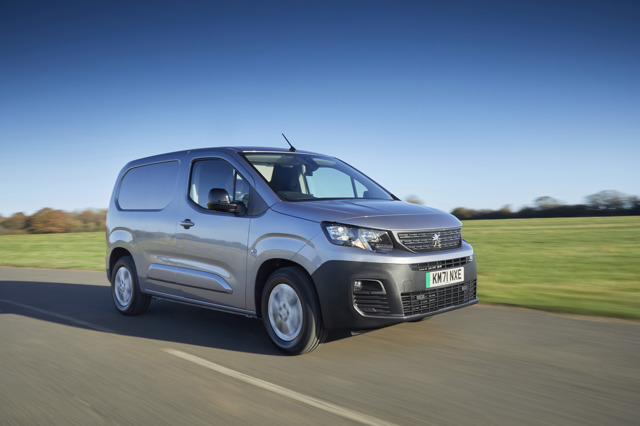Peugeot e-Partner (2022 – 2024) Review
Peugeot e-Partner (2022 – 2024) At A Glance
Peugeot has one of the most diverse portfolios of electric vans in the market right now, with electrified versions of all three of its mainstream delivery vans – the Peugeot Partner, Peugeot Expert and Peugeot Boxster. But is its smallest model fit for the job? Read our Peugeot e-Partner review to find out…
Introduced at the end of 2021, the Peugeot e-Partner is based on the compact Peugeot Partner van, which shares most of its architecture with the Citroen Berlingo, Fiat Doblo and Vauxhall Combo.
The fully electric model uses a 50kWh battery pack and a front-mounted electric motor, developing 135PS and giving a WLTP-measured range of 170 miles. The motor develops a handy 260Nm of torque and comes with a maximum payload of 803kg.
It’s a tidy and neatly styled van with a choice of body lengths (4.4 or 4.7 metres), while the battery is compatible with all types of fast charger, meaning you can get it from 20% to 80% charge in about half an hour. Overnight charging, meanwhile, will take around seven-and-a-half hours from a standard domestic wallbox.
Two trim levels are offered – the business-like Professional and the more driver-focused Asphalt, which gets improved interior trim and body-coloured bumpers.
All models are offered with the option of Peugeot’s ‘Multi-flex’ modular folding three-seater front bench, which allows drivers to increase storage capacity, with load space increasing up to 500 litres inside the cabin using storage space under the centre seat cushion and a load through bulkhead.
Prices are around £12,000 pricier than diesel models, which limits the van’s appeal to those operating in congestion charging areas or covering significant enough distance to negate the additional cost of refuelling.
Driving the Peugeot e-Partner (2022 – 2024)
The standard Peugeot Partner is one of the best small vans to drive and has impressively car-like dynamics, which is unsurprising as it was also developed as a passenger model.
It’s quiet and refined, more so than the diesel as there’s no intrusive engine noise, but wind and road noise are also minimal and it’s a very pleasant vehicle to drive as a result, with extremely comfortable seats and a good driving position. It rides well but can be a little bumpy on broken surfaces when driven unladen.
Handling is great for a van, the battery pack helping to keep the centre of gravity low. There are three drive modes – Eco, Normal and Power. You’ll only get maximum range in Eco but it’s fine for round town use. Normal gives livelier acceleration which can come in handy when traffic opens up, and in Power mode it’s quite vigorous, but this has a massively detrimental impact on range and is only really suitable for overtaking.
Inside the cabin, the Peugeot e-Partner's is well-appointed, with air conditioning, cruise control and Peugeot’s impressive all-digital e-cockpit in all models and an up-to-date touchscreen infotainment system with advanced smartphone compatibility. Apple CarPlay and Android Auto will both work with it.
Plump for the posher Asphalt model and you’ll also get rear cameras and reverse parking sensors, which will help with its fairly restricted rear visibility. Both models feel solidly finished and well-made.
Overall, then, the Peugeot e-Partner is a pretty convincing package and remains one of the best electric vans in its class, although rivals are catching up quickly and compared with vans such as the Renault Kangoo e-Tech and Mercedes-Benz eCitan, the range isn’t as impressive as it once was. Nevertheless, it’s a good quality electric van with a lot going for it.
Peugeot e-Partner (2022 – 2024) interior
Like the diesel-powered Peugeot Partner, the Peugeot e-Partner is a practically designed and functional van with a wide, square load bay and minimal wheelarch intrusion. Opt for the ‘Long’ version and it’ll accommodate two standard Euro pallets in the load bay, with the added practicality of a wide side-loading door.
Opt for the ‘Multi-flex’ layout and you can boost the load bay length to 3.4 metres – ideal for plumber or builders who may occasionally need to accommodate lengthy pipes or wooden poles. There is also a Crew Van model with an extra row of seating, but this has quite an impact on load volume.
Otherwise, it’s a spacious and flexible van with a surprising amount of space on offer, while you can also choose between barn-style rear doors or a lift-up tailgate depending on how you might use it.








:no_upscale():format(webp)/https://cdn.uk.prod.group-mobility-trader.com/images/fallback/coming-soon.webp)

 Smart and well-equipped, excellent driving dynamics, refined, rapid charging option
Smart and well-equipped, excellent driving dynamics, refined, rapid charging option
 Quite pricy, range won’t suit everyone
Quite pricy, range won’t suit everyone
:no_upscale():format(webp)/https://cdn.uk.prod.group-mobility-trader.com/images/cas/a8b0f0d86d3f1c9934efea6beee43b20/9c4b436b90eed55f96cbca41d54cde2f.jpg)
:no_upscale():format(webp)/https://cdn.uk.prod.group-mobility-trader.com/images/cas/4d0a43c33b17593ae23a2cb54df50329/e13db8da20381001a2fcef400002fe73.jpg)
:no_upscale():format(webp)/https://cdn.uk.prod.group-mobility-trader.com/images/cas/6ee37aec9daa380853cb64da7baf6160/d563075b0dfd16b8ecd24dd43822ffa6.jpg)